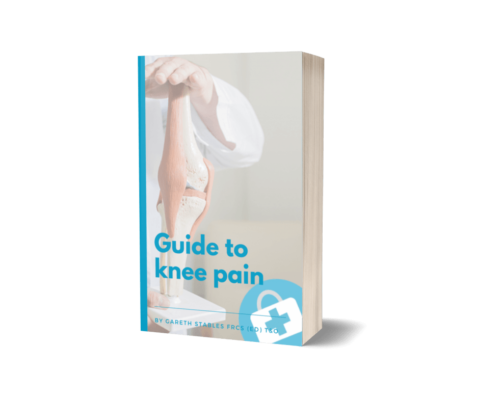Exercise and Osteoarthritis – Why it works
What is Osteoarthritis?
Osteoarthritis is not simply a wear and tear process. If you have osteoarthritis exercise will not wear out your knee faster. Actually the opposite is true. Therapeutic exercise is proven to help with the pain of mild osteoarthritis and doesn’t damage your joint cartilage. In this blog, I’ll have a look at the research to support the idea that you should exercise with knee osteoarthritis.
Why do so many people stop exercising with osteoarthritis?
Have you been told to stop exercising and running because of your knee osteoarthritis? Lots of people believe that osteoarthritis is caused by mechanical wear and tear. Naturally, you might assume that your arthritic knee pain will get worse with exercise or running.
Your GP or therapist may have advised you to stop running, going to the gym or even walking. In most cases, it simply isn’t the right advice. Research now for many years has been telling us the opposite, telling us to keep moving!
Running can help with Knee Osteoarthritis
Exercise is proven to be the most effective treatment for mild and moderate osteoarthritis of your joints. Exercise can help you live longer, it decreases the risks of muscle loss (sarcopenia), frailty and osteoporosis. I’ll take a look now at the evidence with regards to knee pain.
What causes knee osteoarthritis?
There are lots of different potential causes of knee osteoarthritis. For most, it can be due to a number of factors. If you have previously damaged your knee it can lead to a (warning jargon alert!) biologically mediated inflammatory process...don’t worry I’ll explain more!
In our joints, we have 100’s of proteins, cytokines, chemicals and other compounds. These are produced by the lining of our joints or the synovium. In a healthy joint these proteins, cytokines and chemicals support and nourish the cartilage keeping it strong.
If you have an injury, some changes in your metabolism or perhaps due to dietary factors or increased weight something is triggered. Something changes within your knee joint similar to what happens elsewhere in your body with other chronic diseases.
Something is triggered within our genes, in our DNA. This causes your body to produce chemicals that are harmful to your joint cartilage. Over time these chemicals cause the cells in your cartilage to die. In turn, this weakens your cartilage and it becomes more prone to damage.
Weak Cartilage causes knee pain
When your cartilage weakens or becomes thinner it can lead to knee pain, inflammation, and swelling. Osteoarthritis appears to be caused by low-grade chronic inflammation. This is the same type of chronic inflammation that is thought to be a cause of other diseases such as Type 2 diabetes, heart disease and liver disease. Chronic inflammation has also been linked with dementia.
Can exercise improve the chemical balance in my knee?
Scientists are learning more every day about how these proteins and cytokines in our knee joints affect the cartilage and how they can cause osteoarthritis. Exercise has been shown to reduce the number of harmful proteins and cytokines in your joints. In one study the amount of interleukin 10 (IL-10), a substance that protects your knee, was found to increase in people who exercised.
Another substance COMP (Cartilage Oligomeric Matrix Protein) which is produced when cartilage breaks down decreased in subjects knees following exercise. A study showed that COMP levels in the bloodstream increased following exercise, suggesting it might be being “pushed” out of the knee and into the blood and lymphatic system. The body can then remove this harmful chemical.
An increase in IL-10 and a decrease in COMP shows that exercise could actually be beneficial to the health of the cartilage in osteoarthritic knees.
Another study has also shown a decrease in the cytokines in peoples knees after they exercise.
What about the mechanical causes of osteoarthritis?
There are also mechanical causes of osteoarthritis. People with excessive bow-legs (varus) or knock-knee (valgus) alignment will put undue stress on one or other side of their joints. This will make them more prone to developing osteoarthritis.
If you have had a meniscus removed in the past because of a tear then that can put more pressure on your joint surface and lead to osteoarthritis.
Certain fractures or broken bones around the knee joint can lead to post-traumatic arthritis although this is rare.
Can osteoarthritis run in families?
What causes the genes in your DNA to become active and start producing the cytokines associated with osteoarthritis? Well, it could be coded into your specific DNA. In other words, it could be in your genes. So if your parents had osteoarthritis it is more likely that you will be prone to developing it too.
Like other chronic diseases that are passed on from our parents, we can’t do much to alter this risk factor but we can look at the other risk factors we can modify by making the right lifestyle choices. Regular exercise, maintaining a healthy weight and a good diet to name a few.
Can I exercise with knee osteoarthritis?
For over 20 years the research has shown that exercise is beneficial to those suffering from osteoarthritis. Exercise improves pain, strength, and flexibility. Exercise can help you avoid or delay the need for surgery. Exercise can improve your quality of life.
Osteoarthritis is not caused by exercise. Exercise has significant anti-inflammatory effects. You will get other health benefits from regular exercise.
How does exercise improve knee pain due to osteoarthritis?
Osteoarthritis pain is caused by an inflammatory process. The proteins and cytokines in your joint star to change in their makeup and concentrations.
In people who are sedentary the fluid in their knees has been shown to be different from active people. An example is IL-10, a natural anti-inflammatory that your body makes. After exercising the concentration of IL-10 goes up.
Conversely, the concentration of IL-6 a pro-inflammation chemical goes up with sedentary behaviour. If you have arthritis you may notice the effect of this. Think about those first few steps in the mornings. They’re tough, your joints are stiff and your knee hurts. You’ve been sedentary all night so the pro-inflammation chemicals have built up, you start moving and the anti-inflammatory chemicals start to get produced...your knee pain eases.
Osteoarthritis of the knee is linked with an increased risk of death. That means exercise and maintaining healthy habits is really important. Researchers in Denmark have developed a program (GLAD) that has demonstrated significant improvements in the lives of thousands of people suffering from knee osteoarthritis.
Exercise really is the best medicine for knee osteoarthritis. You are not wearing out your joint by walking or running.
So if someone tells you to rest because you have knee osteoarthritis...you know what to tell them (politely)!
How can I get help with my Knee Arthritis?
As with any condition, it’s important to get the right diagnosis and the right advice and treatment sooner rather than later. Often if diagnosed early knee arthritis will respond to non-invasive treatments such as physiotherapy and exercise. If things aren’t settling then here at the My Knee Doc clinic we offer treatments such as specialist knee injections which can help you stay in control of your symptoms without the need for pain-killers.
If you’d like to find out more about how we can help or if you just want to speak to our specialist knee surgeon Mr Gareth Stables then click here and arrange your free call back.



